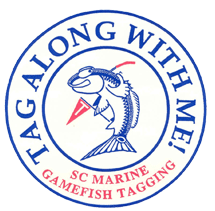Marine - Species
Spot (Leiostomus xanthurus)
General Description
Body silver or bluish above and somewhat golden on belly; 12 – 15 oblique dark streaks extend below lateral line. Mouth small and inferior, lacking barbels on chin. A single dark spot, similar in size to the eyes, is located behind the upper portion of the gill cover.
Average Size
8 inches, 0.5 pounds;
South Carolina State Record: 1 pound, 1 ounce;
maximum age: approx. 5 years.
Habitat
Adults: Inhabit estuaries, tidal creeks, and shallow coastal waters; generally over muddy or sand-mud bottoms; also over oyster reefs and along beaches.
Juveniles: Utilize lower salinity tidal creeks; yearlings progress to deeper water of lower estuaries and inlets; most common over mud or detritus-laden bottoms and seagrass beds.
Reproductive Cycle
- Both sexes mature by 2 years of age; approx. size at maturity: 7 – 8 inches.
- Spawn October – March over outer continental shelf. Adults congregate near inlets and beaches during fall prior to offshore and southerly spawning migrations.
- Larval develop offshore, utilizing currents to reach nearshore waters where they metamorphose into bottom dwellers near estuarine inlets; enter estuaries December – April.
Foraging Habits
- Feed on locally available invertebrates including polychaete worms, amphiods, copepods, small mollusks and detritus; adults gulp sediments and sort out invertebrate prey; juveniles graze on bottom-dwelling invertebrates. Larvae consume zooplankton.
Availability/Vulnerability to Harvest
- One of the most abundant species in estuarine and nearshore coastal waters of the southeast U.S., spot historically supported important commercial and recreational fisheries. Commercial harvest has declined greatly in South Carolina since 1980 but remains significant across the southeast U.S. and northward along the Atlantic coast.
- Abundance in estuaries is primarily temperature-dependent; tolerate wide salinity and temperature fluctuations but move offshore as water cools during fall. Harvested by recreational anglers spring through fall; commercially during the fall run offshore.
- Conservation concerns: degradation and loss of estuarine habitat; pollution and compromised water quality; potential for significant recreational harvest; potential for significant commercial harvest and mortality as by-catch in southeast U.S. shrimp trawl fishery.
Literature Cited
Dawson CE. 1958. A study of the biology and life history of the spot, Leiostomus xanthurus Lacépède, with special reference to South Carolina. Contributions from Bears Bluff Laboratories no. 28, Wadmalaw Island, SC. 48 pp.
Fischer W. 1978. FAO identification sheets for fisheries purposes: western central Atlantic (fishing area 31) volume 1 – 7. Food and Agriculture Organization of the United Nations, Rome.
Goldstein RJ. 2000. Coastal fishing in the Carolinas: from surf, pier, and jetty. John F. Blair Publisher, Winston-Salem, NC. 243 pp.
Hales LS, MJ Van Den Avyle. 1989. Species profiles: life histories and environmental requirements of coastal fishes and invertebrates (South Atlantic) – spot. U.S. Fish Wildl. Serv. Biological Report 82(11.91). U.S. Army Corps of Engineers TR EL-82-4. 24 pp.
Maier P. 2005. Spot. In: Comprehensive Wildlife Conservation Strategy. South Carolina Department of Natural Resources, Columbia, SC. Available: https://www.dnr.sc.gov/cwcs/pdf/Spot.pdf. Accessed: December, 2009.
Mercer LP. 1987. Fishery management plan for spot (Leiostomus xanthurus). Special Scientific Report no. 49., North Carolina Department of Natural Resources and Community Development, Morehead City, NC. 81 pp.
Moore CJ, M Barkley. 2005. South Carolina’s guide to saltwater fishes. South Carolina Department of Natural Resources, Special Publication. Columbia, SC. 132 pp.
Music JL. 1974. Observations on the spot (Leiostomus xanthurus) in Georgia’s estuarine and close inshore ocean waters. Contribution Series Number 28, Georgia Dept. of Natural Resources. 29 pp.
Parker JC. 1971. The biology of the spot, Leiostomus xanthurus Lacépède, and Atlantic croaker, Micropogon undulatus (Linnaeus), in two Gulf of Mexico nursery areas. Texas A&M University, College Station, TX. 182 pp.
Phillips JM, MT Huish, JH Kerby, DP Moran. 1989. Species profiles: life histories and environmental requirements of coastal fishes and invertebrates (mid-Atlantic) – spot. U.S. Fish Wildl. Serv. Biol. Rep. 82(11.98). U.S. Army Corps of Engineers TR EL-82-4. 13 pp.
Warlen SM, AJ Chester. 1985. Age, growth, and distribution of larval spot, Leiostomus xanthurus, off North Carolina. Fish Bull 83: 587-600.


